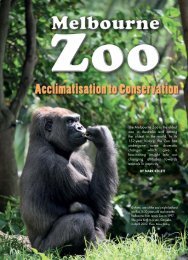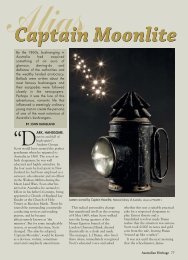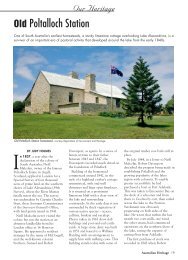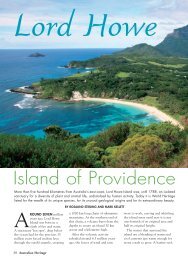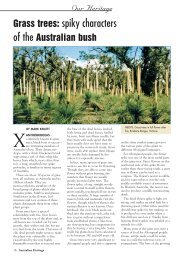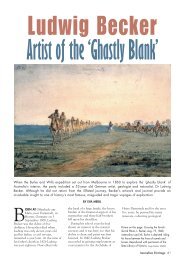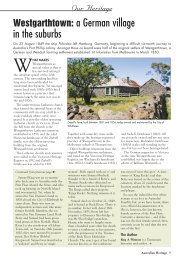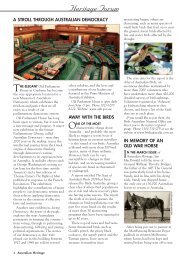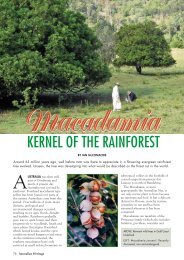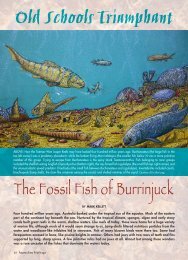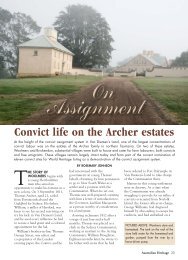Tyger, tyger, burnt out - Australian Heritage Magazine
Tyger, tyger, burnt out - Australian Heritage Magazine
Tyger, tyger, burnt out - Australian Heritage Magazine
Create successful ePaper yourself
Turn your PDF publications into a flip-book with our unique Google optimized e-Paper software.
<strong>Tyger</strong>, <strong>tyger</strong>, <strong>burnt</strong> <strong>out</strong><br />
The demise of the thylacine<br />
The Tasmanian tiger, or thylacine, has acquired almost mythical status since it was hunted to extinction last<br />
century. Once widespread across Tasmania, the <strong>Australian</strong> continent and New Guinea, the thylacine seems<br />
to have been quite susceptible to changes in its habitat, and its fate was sealed when European settlers<br />
decided that it posed an unacceptable threat to their sheep.<br />
BY MARK KELLETT<br />
TALES OF STRANGE<br />
carnivorous beasts lurking in<br />
the forests of Van Diemen’s<br />
Land had been told since<br />
the visit of the Dutch explorer, Abel<br />
Tasman, in 1642. His pilot-major,<br />
Francoys Jacobz, had led a shore party<br />
on the 2nd of December and<br />
described finding “the footing of wild<br />
beasts having claws like a tiger”.<br />
However, his report, as with many<br />
others of strange tracks and halfglimpsed<br />
animals that followed it, is<br />
so vague that modern readers cannot<br />
be certain what animal is being<br />
described (wombats, for example,<br />
have such long claws).<br />
On the 21st of April, 1805, the<br />
Sydney Gazette printed a report of a<br />
strange animal found near the shortlived<br />
settlement at Yorktown on Port<br />
Dalrymple in the north of the island.<br />
An animal of a truly singular and<br />
novel description was killed by dogs<br />
on the 30th of March on a hill<br />
immediately contiguous to the<br />
settlement. From the following<br />
minute description of which, by<br />
Lieutenant Governor PATERSON, it<br />
must be considered of a species<br />
perfectly distinct from any of the<br />
animal creation hitherto known, and<br />
certainly the only powerful and<br />
terrific of the carnivorous and<br />
voracious tribe yet discovered on any<br />
part of New Holland or its adjacent<br />
islands.<br />
Paterson’s detailed description is the<br />
first indisputable account of an animal<br />
PICTURE ABOVE: Male and female of the<br />
Thylacinus cynocephalus. (1841), H. C.<br />
Richter. From Mammals of Australia by John<br />
Gould (1804–1881). Even at this early<br />
date, Gould was pessimistic ab<strong>out</strong> the<br />
thylacine’s survival. National Library of Australia,<br />
nla.pic-vn3292764.<br />
<strong>Australian</strong> <strong>Heritage</strong> 73
that was to become despised by, and<br />
later emblematic of the people of the<br />
island.<br />
It is very evident that this species is<br />
destructive, and lives entirely on<br />
animal food; as on dissection his<br />
stomach was found filled with a<br />
quantity of kangaroo, weighing 5lbs,<br />
the weight of the whole animal 45lbs.<br />
From its interior structure it must be<br />
a brute peculiarly quick of digestion;<br />
the dimensions were, ... length of the<br />
eye, which is remarkably large and<br />
black, 1 3 / 4 inches; ... length of the<br />
tail, 1 foot 8 inches; length of the<br />
fore leg 11 inches; and of the fore<br />
foot, 5 inches; the fore foot with 5<br />
blunt claws; ... stripes across the back<br />
20, on the tail 3; 2 of the stripes<br />
extend down each thigh; length of<br />
the hind leg from the heel to the<br />
thigh, 1 foot; length of hind foot, 6<br />
inches; the hind foot with 4 blunt<br />
claws, the soles of the feet with<strong>out</strong><br />
hair; ... 8 fore teeth in the upper jaw,<br />
and 6 in the under; 4 grinders of a<br />
side, in the upper and lower jaw; 3<br />
single teeth also in each; 4 tusks, or<br />
canine teeth, length of each 1 inch;<br />
... the body short hair and smooth,<br />
of a greyish colour, the stripes<br />
black; the hair on the neck is<br />
rather longer than that on<br />
the body; the hair on the<br />
ears of a light brown<br />
colour, on the inside<br />
rather long. The form<br />
of the animal is<br />
that of a hyaena, at<br />
the same time<br />
strongly<br />
reminding the<br />
observer of the<br />
appearance of a<br />
low wolf dog.<br />
Van Diemen’s<br />
Land’s first Surveyor-<br />
General, George Harris,<br />
officially described the animal in<br />
1806 on the basis of two male<br />
specimens that had been caught with<br />
traps baited with kangaroo-meat.<br />
Placing it in the same genus as the<br />
American opossums, he gave it the<br />
scientific name of Didelphis<br />
cynocephala (dog-headed opossum).<br />
The creature he described would<br />
come to be known by an astonishing<br />
range of common names, almost all of<br />
them misleading as to its affinities:<br />
legunta, dog-faced dasyurus, hyena<br />
opossum, zebra opossum, Tasmanian<br />
dingo, pouched wolf, striped wolf,<br />
Tasmanian wolf, zebra wolf, and<br />
Tasmanian tiger. In 1824 another<br />
naturalist, Coenraad Temminck,<br />
recognised the animal as distinct from<br />
the American marsupials and gave its<br />
modern name: Thylacinus cynocephalus<br />
(pouched and dog-headed), and<br />
hence thylacine, the common name<br />
now most often used.<br />
The thylacine superficially<br />
resembled a German shepherd dog in<br />
size and shape. However, while dogs<br />
are placental mammals, thylacines<br />
were marsupials related to the<br />
Tasmanian devil, giving birth to up to<br />
four young at an early stage of<br />
development and rearing them in a<br />
backward-facing pouch. In a process<br />
called convergent evolution, the<br />
similar way of life adopted by the<br />
ancestors of thylacines<br />
and dogs led to their<br />
descendants<br />
developing a<br />
similar form.<br />
Zebra, or dog-faced dasyurus. Didelphis<br />
cynocephala. Harris, James Basire, Georges<br />
Cuvier, State Library of Tasmania. Clearly the artist<br />
had not seen the living animal.<br />
There were other important<br />
differences between dogs and<br />
thylacines. Thylacines had a rather<br />
stiffer spine and tail, shorter legs, and<br />
feet that were held flatter to the<br />
ground than dogs of similar size. This<br />
combination of features gave it a<br />
different gait, endowing the animal<br />
with endurance at the expense of<br />
speed. Certainly dogs seem to have<br />
easily caught up with them. Perhaps<br />
misled by the fact that the thylacine’s<br />
front legs are rather shorter than the<br />
rear, R M Martin noted in his History<br />
of Austral-Asia of 1839, “...in running<br />
it bounds like a kangaroo, though not<br />
with such speed.”<br />
The thylacine may have attempted<br />
to catch its prey in an ambush, but if<br />
that failed, it would patiently trot<br />
after its prey. Its persistence was<br />
notable, as a miner named Oscar<br />
described in the Mercury in 1882:<br />
“This native tiger is not swift, and is<br />
very awkward in turning, but it<br />
follows the trail by its never-erring<br />
scent, and in the long run is sure of<br />
its prey.”<br />
When the thylacine caught up with<br />
its prey, usually small kangaroos,<br />
wallabies, possums, sometimes<br />
native rodents, bandicoots, birds,<br />
lizards and even echidnas, its<br />
jaws and teeth were put to<br />
work. Its jaw had the largest<br />
gape of any land mammal and<br />
could close with great force, as<br />
the hunter Hugh Mackay related:<br />
A bull-terrier once set upon a wolf<br />
and bailed it up in a niche in some<br />
rocks. There the wolf stood, with its<br />
back to the wall, turning its head<br />
from side to side, checking the terrier<br />
as it tried to butt in from alternate<br />
and opposite directions. Finally the<br />
dog came in close and the wolf gave<br />
one sharp, fox-like bite, tearing<br />
a piece of the dog’s skull<br />
clean off and it fell<br />
with its brain<br />
protruding, dead.<br />
Like other<br />
carnivorous<br />
marsupials, its fangs<br />
were oval and suited for<br />
crushing, while the<br />
molars were somewhat<br />
primitive and shaped for<br />
cutting (dogs, by contrast, have<br />
slashing canines and a mixture of<br />
slicing and crushing molars).<br />
Thylacine teeth are almost unworn,<br />
supporting records of the marsupial<br />
delicately picking <strong>out</strong> the most<br />
nutritious parts of its prey: the heart,<br />
lungs, liver, kidneys, and if it was<br />
really famished, the muscle from the<br />
inner thighs, leaving the rest for<br />
scavengers like Tasmanian devils.<br />
This fussy diet may have led to the<br />
wholly erroneous belief that the<br />
thylacine fed on blood, first recorded<br />
by British scientist Geoffrey Smith in<br />
1909. This myth doubtless helped to<br />
make the animal an object of hatred<br />
and fear.<br />
Though it is difficult to reconstruct<br />
the behaviour of an extinct animal,<br />
some of the most striking differences<br />
74 <strong>Australian</strong> <strong>Heritage</strong>
A rare photograph of one of the last thylacines held in captivity. Like ‘Benjamin’, who was possibly the last member of the species, its end was<br />
probably a lonely one.<br />
between thylacines and dogs might<br />
have been behavioural. It is now<br />
known that many marsupials have a<br />
brain two-thirds the size of placental<br />
mammal of similar size and habit, and<br />
thylacines were no exception to this.<br />
This may have been the result of a<br />
simpler social structure, thylacines<br />
hunted alone or perhaps as a mated<br />
pair or as a mother with joeys, while<br />
dogs form much larger packs. With<br />
less need to communicate, thylacines<br />
do not seem to have vocalised much,<br />
communicating among themselves<br />
with a muted coughing bark and<br />
giving a hissing growl when<br />
antagonised. Ultimately, the<br />
thylacines smaller brain and simpler<br />
behaviour may have reduced its<br />
capacity to adapt to the changes that<br />
overtook it.<br />
The thylacine was the last survivor<br />
of a once successful family. Twelve<br />
fossil members of the thylacine family<br />
are described in a recent paper by<br />
Stephen Wroe, ranging from fox-sized<br />
to wolf-sized predators, most of which<br />
lived between 20 million and 8<br />
million years ago in different parts of<br />
Australia, Tasmania and New Guinea.<br />
Over this period, there seem to have<br />
been between four or five thylacine<br />
species living at any given time. By<br />
the time the first Aboriginal people<br />
arrived some 60,000 years ago, their<br />
fortunes had waned and only the<br />
modern thylacine remained.<br />
Thylacines became extinct in New<br />
Guinea ab<strong>out</strong> 10,000 years ago and in<br />
mainland Australia ab<strong>out</strong> 3,000 years<br />
ago. Although the causes of these<br />
extinctions are not known, the<br />
disappearance of the thylacine in<br />
Australia coincided with the arrival of<br />
the first dingos (Canis familiaris). It<br />
has been suggested that the dingo may<br />
have competed catastrophically with<br />
the mainland thylacine for food and<br />
living space. Though there are<br />
suggestions that small relic thylacine<br />
populations may have persisted on the<br />
mainland, only in Tasmania, isolated<br />
from the mainland by Bass Strait<br />
ab<strong>out</strong> 12,000 years ago, did it survive<br />
to be seen by Europeans with<br />
certainty.<br />
This isolation ended abruptly in<br />
1803 when the British colonised Van<br />
Diemen’s Land in a move to thwart<br />
any territorial ambitions of the<br />
French. A year later Hobart Town<br />
(later Hobart) and Patersonia (later<br />
Launceston) were founded. Two<br />
animals that came in the company of<br />
the settlers were to prove deadly for<br />
the thylacine.<br />
In the chaotic conditions of the<br />
early settlements, some domestic dogs<br />
escaped and formed feral packs. It is<br />
possible that such wild dogs attacked<br />
thylacine; domestic dogs have been<br />
described as being either terrified or<br />
enraged by them. Dogs also would<br />
have competed with thylacines for the<br />
kangaroos and wallabies that made up<br />
the bulk of its diet. Ultimately, the<br />
worst effect of feral dogs on the<br />
thylacine would turn <strong>out</strong> to be an<br />
indirect one.<br />
In the early Tasmanian settlements,<br />
sheep were primarily a food supply for<br />
the colonists, though small numbers of<br />
wool-producing sheep were on the<br />
island as early as 1806. With the<br />
mainland settlements making fortunes<br />
from wool, significant numbers of<br />
merino sheep began to arrive in Van<br />
Diemen’s Land after 1820. There were<br />
some losses among these early flocks<br />
and. although it does not seem<br />
unreasonable that thylacines might<br />
have been responsible for some of<br />
them, reports of spree-kills of sheep<br />
seem more likely to have been the<br />
work of dogs. However, a series of<br />
mistaken human acts ensured that the<br />
thylacine would take the blame.<br />
By 1819, the Van Diemen’s Land<br />
flocks were more than twice the size<br />
of those of the New S<strong>out</strong>h Wales<br />
colonies. Anxious to maintain<br />
investment in the mainland colony,<br />
W C Wentworth wrote ab<strong>out</strong> a wholly<br />
imaginary “animal of the panther<br />
tribe” that “...commits dreadful havoc<br />
among the flocks.”. Unfortunately,<br />
this was misconstrued as a description<br />
of the thylacine, and three years later<br />
the Surveyor General, George<br />
William Evans, paraphrased<br />
Wentworth’s description in the<br />
Description of Van Diemen’s Land.<br />
In 1826 the Van Diemen’s Land<br />
Company was granted extensive<br />
<strong>Australian</strong> <strong>Heritage</strong> 75
A more accurate portrayal of the thylacine from The Mammals of Australia,1869, Harriet Scott, Thomas Richards, Victor A Pr<strong>out</strong>, Allport Library and<br />
Museum of Fine Arts.<br />
holdings in the north-west of the<br />
island to farm sheep. However, the<br />
land was poorly selected and the sheep<br />
died of exposure or starvation, or were<br />
taken by predators, human and<br />
animal, imported and indigenous.<br />
Ignoring the more serious difficulties,<br />
the company’s directors seized on the<br />
wild predators as a problem they could<br />
solve. In 1830 the company offered<br />
five shillings for male thylacines and<br />
seven for females, with half these<br />
amounts for Tasmanian devils and<br />
feral dogs, an odd choice, considering<br />
that the company’s records indicate<br />
that dogs were responsible for most<br />
kills. The company offered rewards for<br />
thylacines on and off until into the<br />
next century, and other graziers<br />
followed its example. It seems that<br />
this bounty-hunting may have only<br />
reduced thylacine numbers near<br />
inhabited areas, but did set a<br />
precedent for how the animal was to<br />
be dealt with.<br />
Prophetically, the great naturalist,<br />
John Gould, suggested in his classic<br />
Mammals of Australia that the<br />
thylacine might not be able to<br />
withstand such persecution<br />
indefinitely:<br />
When the comparatively small island<br />
of Tasmania becomes more densely<br />
populated, and its primitive forests are<br />
intersected from the eastern to the<br />
western coast, the numbers of this<br />
singular animal will speedily diminish,<br />
extermination will have its full sway,<br />
and it will then, like the Wolf in<br />
England and Scotland, be recorded as<br />
an animal of the past: although this<br />
will be a source of much regret,<br />
neither the shepherd nor the farmer<br />
can be blamed for wishing to rid the<br />
island of so troublesome a creature.<br />
Through the 1880s, the wool<br />
industry was in crisis, and the colonial<br />
government was under pressure to<br />
help the industry. Although a crash in<br />
the price of wool, drought, disease,<br />
rabbit plagues and wild dogs were the<br />
main problems, wealthy farmers’ lobby<br />
groups like the Buckland and Spring<br />
Bay Tiger and Eagle Extermination<br />
Association, the Glamorgan Stock<br />
Protection Association, the Oatlands-<br />
Ross Landowners Association and the<br />
Midlands Stock Protection<br />
Association agitated for the<br />
government to take action against the<br />
thylacine.<br />
They found their voice in the<br />
ambitious Tasmanian House of<br />
Assembly member for Glamorgan,<br />
John ‘Tiger’ Lyne. In 1886, after citing<br />
the inflated figure of “...30,000 or<br />
40,000 sheep were killed annually by<br />
dingoes”, and arguing that since the<br />
thylacines were breeding on crown<br />
land the onus was on the government<br />
to control them, he proposed £500 be<br />
set aside each year for the destruction<br />
of the thylacine, with £1 paid for each<br />
adult thylacine killed and 10 shillings<br />
for each pup. In the face of dissent<br />
ab<strong>out</strong> the cost of the proposal, the bill<br />
was deadlocked. It was only passed<br />
with the vote of the Speaker of the<br />
House, Alfred Dobson, an action<br />
against custom whereby the Speaker is<br />
expected to vote against such a<br />
deadlocked bill. The first bounty was<br />
paid in 1888. Deafness forced Lyne to<br />
retire from politics in 1893, but 2184<br />
thylacines were to be killed as a<br />
consequence of his attempt to seek<br />
the vote of the woolly aristocracy.<br />
The task of hunting the thylacine<br />
fell to ‘tiger men’. The animal’s shy,<br />
solitary and nocturnal nature made it<br />
difficult to hunt. Some trapped the<br />
marsupial with a snare left in a hole in<br />
76 <strong>Australian</strong> <strong>Heritage</strong>
a fence or on a forest game trail.<br />
Others used dogs to track and corner<br />
the thylacine.<br />
Tiger men returning from a hunt<br />
took the carcasses to the local police<br />
station, where the ears and toes were<br />
clipped to show that a bounty had<br />
been paid. Farmers would sometimes<br />
pay an equivalent bounty for a<br />
thylacine carcass. The carcass itself<br />
seems to have been considered useless.<br />
It has often been said that thousands<br />
of waistcoats were made of the<br />
animal’s pelts, but this seems to be<br />
apocryphal; certainly no such garment<br />
is known to exist now. A few<br />
thylacine-skin rugs were made, and a<br />
rather ghoulish individual made a<br />
pincushion with a thylacine skull.<br />
Not everyone applauded the<br />
slaughter. Like most carnivores, adult<br />
thylacines were wary of man, but joeys<br />
taken young enough could be readily<br />
tamed and trained. In 1842 the<br />
botanist Ronald Gunn described his<br />
experience of raising and taming three<br />
thylacine joeys in the Papers and<br />
Proceedings of the Royal Society of Van<br />
Diemen’s Land. He was a rare voice of<br />
support for the thylacine, asserting “It<br />
seems far from being a vicious animal<br />
at its worst, and the name Tiger or<br />
Hyaena gives a most unjust idea of its<br />
fierceness.”<br />
Zoos had also acted to improve the<br />
thylacine’s reputation. They were kept<br />
locally in Hobart and Launceston, on<br />
the mainland in Sydney, Melbourne<br />
and Adelaide and as far away as<br />
Britain, Germany, Austro-Hungary,<br />
America, India and S<strong>out</strong>h Africa.<br />
They were not regarded as very<br />
glamorous creatures; like most<br />
carnivores in captivity they were<br />
rather smelly, and forcing the animal<br />
to be active during the day made<br />
them lethargic and stressed. Zoos<br />
made no direct contribution to the<br />
conservation of the thylacine, as they<br />
were not kept in such a way as to<br />
encourage breeding in captivity, but<br />
they did act to shift public opinion<br />
away from the belief that the animal<br />
was a blood-drinking monster. There<br />
were tentative calls for its destruction<br />
to be curbed.<br />
By this time the animal was in need<br />
of such protection. Each year the<br />
bounty was in effect, the government<br />
was paying for 100 or so thylacines.<br />
This number halved in 1906 and,<br />
when the bounty was withdrawn in<br />
1909, only two bounties had been<br />
paid. Prices offered by zoos, between<br />
£7 and £8, had something to do with<br />
this. But it was also clear that the<br />
thylacine had undergone an islandwide<br />
population crash. Its exact cause<br />
is not known, though contemporary<br />
reports of thylacines suffering from a<br />
debilitating disease must be<br />
considered a possible cause.<br />
After the Great War it was apparent<br />
the thylacine was very rare. Prices<br />
offered by zoos rose again and again,<br />
London zoo paying £150 for one in<br />
1926. Scientists and naturalists like<br />
Thomas Flynn, Professor of Zoology at<br />
the University of Tasmania, and Clive<br />
Lord, director of the Tasmanian<br />
Museum, patiently fought through a<br />
political smokescreen that the<br />
thylacine was in no danger and a<br />
bureaucratic minefield to have the<br />
thylacine protected. In 1930 they<br />
succeeded in getting a ban on hunting<br />
thylacines during their breeding<br />
season in December and on the<br />
international traffic in live animals.<br />
Yet it was still shot for sport or as a<br />
pest. In the same year a farmer from<br />
Mawbanna named Wilf Batty,<br />
incensed by an adult female<br />
thylacine’s spree in a chicken coop,<br />
became the last man indisputably to<br />
have shot a wild thylacine.<br />
Surprisingly, there is controversy<br />
ab<strong>out</strong> the identity of the last<br />
thylacine in captivity. The female<br />
could either have been sold to the zoo<br />
as a joey by Walter Mullins in 1924<br />
along with her mother and two littermates,<br />
or as an adult in 1933 by Elias<br />
Churchill. It is possible that both are<br />
true, that when the older thylacine<br />
died she was discreetly replaced with<br />
the younger one, as a parent may<br />
replace a child’s beloved budgie to<br />
avoid a fuss.<br />
In 1933 she was visited by David<br />
Fleay, who had unsuccessfully applied<br />
for the position of Director of the<br />
Tasmanian Museum. While in the<br />
Native Tiger of Tasmania shot by Weaver 1869 (Thylacine), 1869. Tasmanian Museum and Art Gallery.<br />
One of the few photographs of a thylacine from the 19th century.<br />
<strong>Australian</strong> <strong>Heritage</strong> 77
Thylacine: Wilf Batty with animal shot at Mawbanna, 1931. Tasmanian Museum and Art Gallery. Note<br />
the terrified reaction of the dog to Batty’s kill.<br />
vicinity, he gained the zoo’s<br />
permission to enter the animal’s<br />
enclosure and film it. While Fleay was<br />
arranging the camera, the thylacine<br />
crept around and bit him on the<br />
backside. Fleay was more amused than<br />
angry, and carried the scar proudly for<br />
the rest of his days. This incident<br />
produced just over a minute of silent,<br />
black and white footage that is the<br />
only film record of the thylacine.<br />
The last thylacine in captivity died,<br />
alone and neglected, on the 7th of<br />
September, 1936. Ironically, she had<br />
spent the last two months of her life<br />
as what seems to have been the sole<br />
representative of a completely<br />
protected species. Even more<br />
ironically, as the result of an apparent<br />
scam by a Geelong resident named<br />
Frank Darby, she has come to be<br />
known as Benjamin.<br />
It took some time for people to<br />
realise that the thylacine had become<br />
extinct. Books written as late as the<br />
1970s either describe the thylacine as<br />
a living animal or as “possibly<br />
extinct”. Expeditions were sent <strong>out</strong><br />
over the twentieth century, among<br />
them one led by Fleay in 1945, with<br />
their objective gradually changing<br />
from capturing one for a zoo to<br />
proving the continued existence of<br />
the species. However, none of them<br />
yielded anything other than brief,<br />
unverifiable sightings and smudged<br />
prints.<br />
Proving an animal is extinct, like<br />
proving any negative, is difficult. A<br />
rule of thumb commonly accepted<br />
among biologists is that if there has<br />
been no indisputable evidence of an<br />
organism for 50 years, the animal is<br />
considered extinct. Although there is<br />
a background noise of sightings in<br />
Tasmania and even a few on the<br />
mainland and New Guinea, none are<br />
accompanied by indisputable<br />
evidence. When even a recent $1.2<br />
million reward offered by the Bulletin<br />
magazine cannot produce such<br />
evidence, it appears the animal is<br />
indeed extinct.<br />
Ironically, the people whose<br />
ancestors harried the thylacine <strong>out</strong> of<br />
existence have adopted it as a mascot.<br />
A pair of thylacines flanks the<br />
Tasmanian coat of arms and anyone<br />
who wishes to show their pride in<br />
their Tasmanian heritage, from the<br />
environmentalist lobby to big<br />
business, places one on their banner.<br />
It is a pity the animal could not have<br />
gained such status while it was alive,<br />
though perhaps it could only adopt<br />
such a cuddly image by being safely<br />
dead.<br />
In 1999 a team based in the<br />
<strong>Australian</strong> Museum led by Michael<br />
Archer sought to reverse this<br />
situation. They hoped to isolate DNA<br />
from a thylacine joey preserved in<br />
spirits in 1866, with the ultimate aim<br />
of cloning the animal and<br />
regenerating the species. Although the<br />
team was able to succeed in its first<br />
goal, and even got as far as<br />
determining the sequence of three<br />
thylacine genes, in 2005 it was<br />
realised that genetic technology is<br />
simply not advanced enough to<br />
achieve Archer’s very ambitious<br />
objective.<br />
What is known ab<strong>out</strong> the thylacine<br />
has been reconstructed from<br />
examination of dead specimens and<br />
from a motley assembly of the<br />
recollections of people who claimed to<br />
know it, most of whom are now dead.<br />
Though this approach is useful, it<br />
leaves many questions unresolved.<br />
When the biology and ecology of the<br />
animal itself are disputed, the forces<br />
that pushed it to extinction must be<br />
similarly unclear. How important was<br />
hunting? How important was landclearing?<br />
How important were dogs;<br />
and if so, was it directly, by hunting,<br />
or indirectly through competition for<br />
food sources? What role, if any, did<br />
disease play?<br />
Any change in the relative<br />
importance of these factors ultimately<br />
alters the answer posed by modern<br />
scientists and naturalists: could the<br />
thylacine have been saved? Since<br />
their predecessors could not even<br />
determine whether the marsupial<br />
should have been saved, the question<br />
will remain unanswered.<br />
The Author<br />
Dr Mark Kellett is a biologist and a<br />
freelance science writer.<br />
Further Reading<br />
Thylacine by David Owen, Allen &<br />
Unwin, 2003.<br />
The Last Tasmanian Tiger by Robert Paddle,<br />
Cambridge University Press, 2000.<br />
<strong>Australian</strong> Marsupial Carnivores: Recent<br />
Advances in Palaeontology by Stephen<br />
Wroe, in Predators with Pouches: the<br />
Biology of Carnivorous Marsupials, edited<br />
by Menna Jones, Chris Dickman &<br />
Mike Archer, CSIRO Publishing, 2003.<br />
Mammals of Australia by John Gould,<br />
annotated by Joan M Dixon,<br />
Macmillan, 1983.<br />
Furred Animals of Australia by Ellis<br />
Troughton, Angus and Robinson, 1946.<br />
The Doomsday Book of Animals by David<br />
Day, Ebury Press, 1981.<br />
Extinct by Anton Gill and Alex West,<br />
Channel 4 Books, 2001 (the television<br />
documentary series is also very useful).<br />
The Thylacine Museum website:<br />
www.naturalworlds.org/thylacine ◆<br />
78 <strong>Australian</strong> <strong>Heritage</strong>



